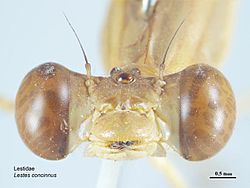
The insect family Coenagrionidae is placed in the order Odonata and the suborder Zygoptera. The Zygoptera are the damselflies, which although less known than the dragonflies, are no less common. More than 1,300 species are in this family, making it the largest damselfly family. The family Coenagrionidae has six subfamilies: Agriocnemidinae, Argiinae, Coenagrioninae, Ischnurinae, Leptobasinae, and Pseudagrioninae.

The Platycnemididae are a family of damselflies. They are known commonly as white-legged damselflies. There are over 400 species native to the Old World. The family is divided into several subfamilies.

Ceriagrion is a genus of damselfly in the family Coenagrionidae. Species of Ceriagrion are small to medium size, generally brightly coloured damselflies. They are found across the Old World, Africa, Asia and Australia.

Indolestes is a genus of damselflies in the family Lestidae. Species of Indolestes can be medium-sized, dull coloured dragonflies. They are found from India through Asia, Australia and the Pacific.
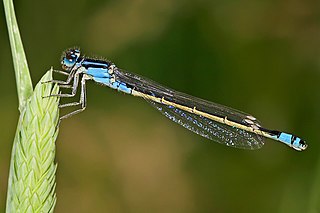
Ischnura is a genus of damselflies known as forktails in the family Coenagrionidae. Forktails are distributed worldwide, including various oceanic islands. The males have a forked projection at the tip of the abdomen which gives the group their common name.

Rhinocypha is a genus of damselflies in the family Chlorocyphidae.
Sinhalestes orientalis, the emerald Sri Lanka spreadwing, is a monotypic species of damselfly in the family Lestidae. The species was thought to be extinct since none have been found since it was first scientifically described in 1862. However, in 2012 this species was re-discovered by a young odonatologist Amila Sumanapala from the Peak Wilderness Sanctuary, Sri Lanka.

Sympecma fusca, the common winter damselfly, is a damselfly a member of the Lestidae and related to the emeralds or spreadwings.

Lestes praemorsus is a damselfly species in the family Lestidae. It is commonly known as the scalloped spreadwing or sapphire-eyed spreadwing. It is very widely distributed from India to China and south to New Guinea.

The elegant spreadwing is a species of damselfly in the family Lestidae, the spreadwings. It is native to eastern North America, including eastern Canada and the United States.

Lestes dryas is a species of damselfly in the family Lestidae, the spreadwings. Its common names include emerald spreadwing, scarce emerald damselfly and robust spreadwing. An alternate name in Ireland is the turlough spreadwing.

Lestes viridulus, the emerald-striped spreadwing, is a damselfly species in the family Lestidae, the spreadwings. It is native to Bangladesh, India, and Thailand.

Indolestes gracilis is a species of damselfly in the family Lestidae. It is known only from Sri Lanka, South India and Cambodia.

Lestes elatus is a species of damselfly in the family Lestidae, the spreadwings. It is known commonly as the emerald spreadwing. It is native to India, Thailand and Sri Lanka.

Lestes nodalis is a species of damselfly in the family Lestidae, the spreadwings.
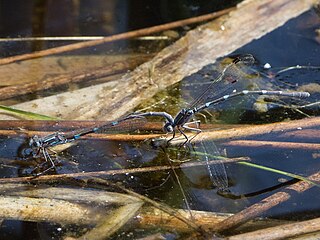
Austrolestes io is an Australian species of damselfly in the family Lestidae, commonly known as an iota ringtail. It has been found in both south-western Australia as well as south-eastern Australia where it inhabits pools, lakes and ponds.
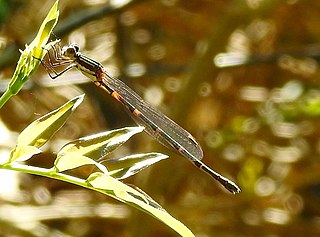
Austrolestes leda is an Australian species of damselfly in the family Lestidae, commonly known as a wandering ringtail. It is found across eastern Australia where it inhabits slow and still water.
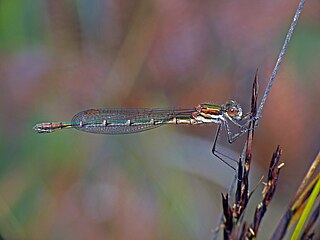
Austrolestes psyche is an Australian species of damselfly in the family Lestidae, commonly known as a cup ringtail. It is found in south-eastern Australia where it inhabits pools, lakes and swamps.

Pseudagrion australasiae is a species of damselfly in the family Coenagrionidae. It is found in India, China, Indonesia, Malaysia, Myanmar, Singapore and Thailand.







